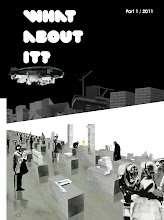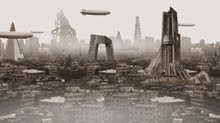 Post(card) Ideological Icon #1, Suprematism, Lazar Khidekel 1927_ OMA, 2006
Post(card) Ideological Icon #1, Suprematism, Lazar Khidekel 1927_ OMA, 2006
Post(card) Ideological Icons
What About revisiting the hardcore shapes of the avant-garde?
It has been almost a century since the air was heavily saturated with the combustible gas of ideology. Almost a hundred years have passed since everything from film, through art and architecture, to urbanism was susceptible to the slightest friction in the atmosphere sparking endless manifestoes and multiple visions of the perennial “new beginning”. But what happens when the ideological fire that fuels urbanism is extinguished, and in its place just smoke remains? What is left after the idealistic energy of the avant-garde has vanished and we are left with necrophilic icons of dead ideologies? Why aren’t we able to see the striking similarities and contrasting disparities between the avatars of yesterday’s ideological urbanism and today’s pop-architectural icons?
In the twenties imaginary taut wires, steel trusses, and structural concrete gave form to the muscular monuments of a Potemkinesque avant-garde. Utopia had a shape. First, it looked like a steel tower spiraling hastily towards the sky, then like a leaning tribune for Lenin, then it took the shape of a sky hook fearlessly cantilevering above the debris of the old city, and of a flying city, soaring in circles weightlessly through the firmament. Not only had the avant-garde announced a victory over the sun, but it promised to use urbanism to melt into air all the solid problems of society.
But, at the point when all possible sorts of fantastic operations on the city were about to be orchestrated, the urban intelligentsia crashed headlong into an ideological wall.
If the dreams of the avant-garde were an improbable mission when their idealistic nostalgia was at its peak, it became almost impossible for them to succeed with a looming economic meltdown, asphyxiating ideological persecutions, and the authorities’ sudden aesthetic preference for neo-classical kitsch—who can forget Boris Iofan’s cake-shaped tower?
In the midst of the suffocating pessimism of the sociopolitical atmosphere of the post-war, the avant-garde managed to find an ideological plateau, and develop in it one last (desperate?) plan. With the catastrophic arrival of the Second World War, Utopia had to change shape. If before the war, urbanism was about tabula rasa, and the ideal new cities were to substitute the old urban fabric with ideological monuments, the new urbanism promised to leave the old cities untouched. The new avant-garde proposed to disguise its ideal cities as colossal buildings that could be developed ad infinitum; urbanism as endless architecture.
The second—and last— coming of ideological urbanism in the 20th century happened fifty years ago. Aroused by the promising future of the new communication, transportation and construction technologies, the new forms of urbanism were grafted around metabolic systems of urbanization, prefabricated instant cities, and Megastructures.
A new ontology of urban forms was created after a whole new cosmos of ideal cities took over the collective intelligence of urbanism. The image of urbanism suffered a dramatic transformation as ideological cities hovered like weightless blankets above the Champs-Élysées, mirror-coated monuments roamed endlessly through the streets of Graz, pixilated buildings, helix-shaped towers, and mushroom-cloud megaliths metabolically proliferated all over Tokyo, geodesic domes sequestered complete areas of Manhattan island, and entire cities were pictured strolling over the surface of the world’s oceans.
Yet again, so suspicious were the proposals of an avant-garde so detached from reality, so economically unfeasible, so ideologically naïve, that they never found (outside of Japan) any possible application or a client devout enough to believe in their projects.
Today’s generation of media-wise, economically proficient, politically correct architects have decided to resurrect the shapes of the most subversive and energetic forms of urbanism of the last century. In the form of an opportunistic architectural cadavre-exquis (started by one, finished by the other) contemporary urbanism has, under the slogan “the stronger the ideal, the sharper the icons” unearthed some of the most the striking proposals of the avant-garde and repurposed them as harmless and ready to consume coffee-table images.
Like when an archeological discovery loses its history-rich past to the frivolity of the museum walls, the icons of the ideological avant-garde have been sterilized, reupholstered and served up to an image-starving audience that devours them as visual gourmet while overlooking their original potential. Prosthetic appendixes of ideologies that expired decades ago, these architectures now captivate the flash of the cameras and win the praise of the critics due to their bold shapes, iconic presence, and their historical ideological references. Exhaustively photographed, printed, blogged, discussed, awarded, these urban forms have metamorphosed from being the icons of a revolution to being the pretty faces of architectural mass media; hardcore urban ideology as architectural soft porn.

Post(card) Ideological Icon #2, Constructivism, El Lissitzky 1924_ Steven Holl, 2002-09
Post(cards)
Agitational provocations in the form of architectural post(cards), the following images have been structured to stimulate the critical understanding of ideological urbanism, to recognize the use of iconographic architecture as its deus ex machina and to identify the recycling of its most intense proposals by contemporary architecture.
By meticulously selecting two formally related buildings and grafting them together like pictures of an alternative reality, the images have the potential to expose two opposed instances in the evolution of urbanism; first as ideological enterprises, then as harmless architectural icons.
On the left side of the post(cards) stand the icons of the urban intelligentsia. Product of their zeitgeist, these buildings share an intense and turbulent history that saw them rise from the collective nostalgia of the ideological optimistic years of the avant-garde, only then to be crumbled away by the inexorable forces of modernity like sand castles in front of a tsunami. The images display symptomatic manifestations of hardcore ideological urbanism in the form of constructivist sky-hooks, non-objective architectons, and metabolist helicoids.
Standing at the opposite side of the image, a series of contemporary architectures strikingly resemble their ideological predecessors. Like organs without a body, these icons’ lack of any clear ideological manifesto, put into evidence how contemporary architecture not only borrows its shapes, but that through image overexposure, and over use, neutralizes the inherent potential of previous forms of ideological urbanism. The new icons offer no hidden subversive messages, state no unprecedented manifestoes, and represent no underground ideologies. The more they become infatuated with their own image, the more they become like Architectural postcards.
By Nathalie Frankowski and Cruz Garcia

Post(card) Ideological Icon #3, Metabolism, Kisho Kurokawa 1961_ JDS, 2006


















































































